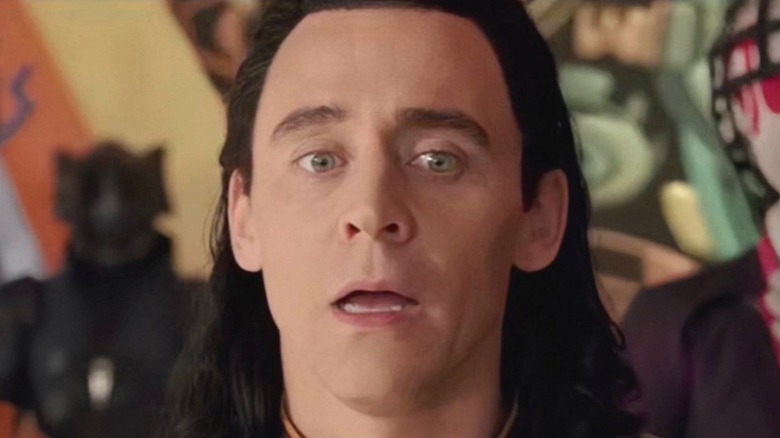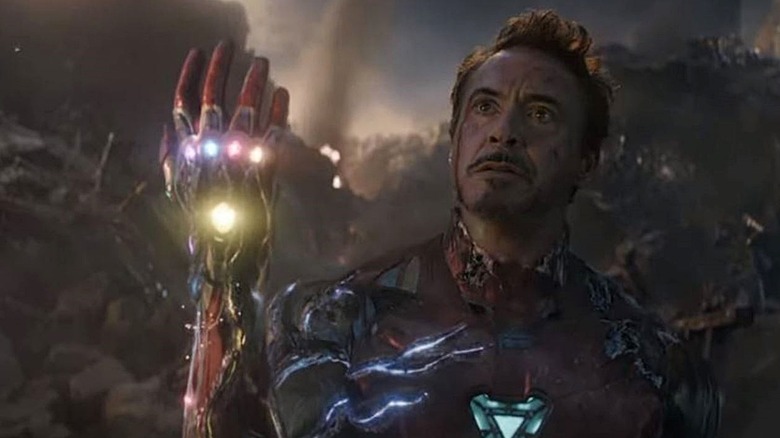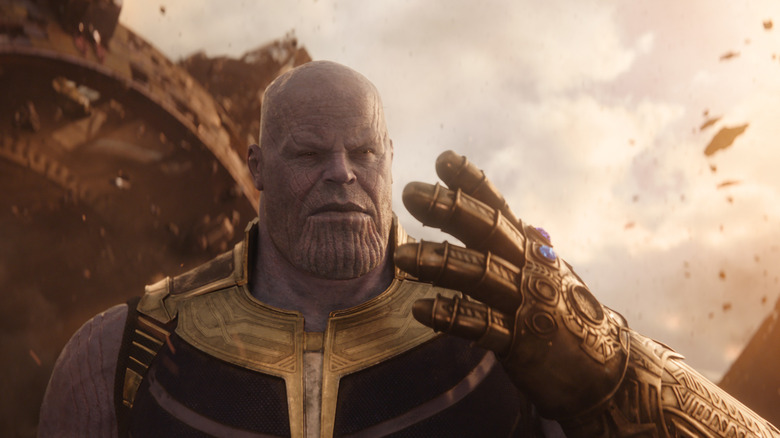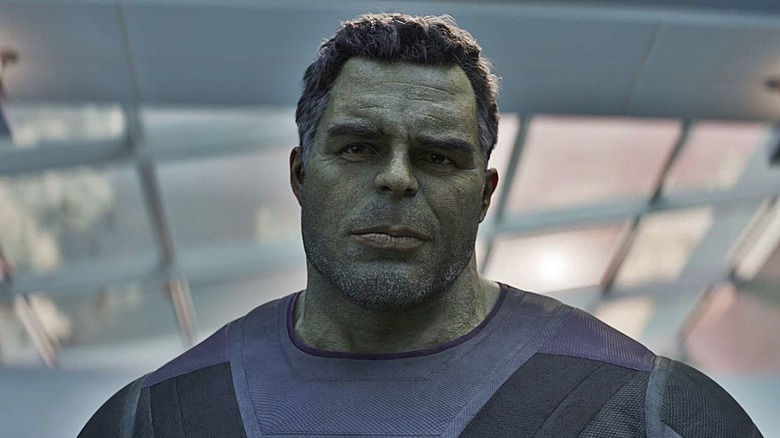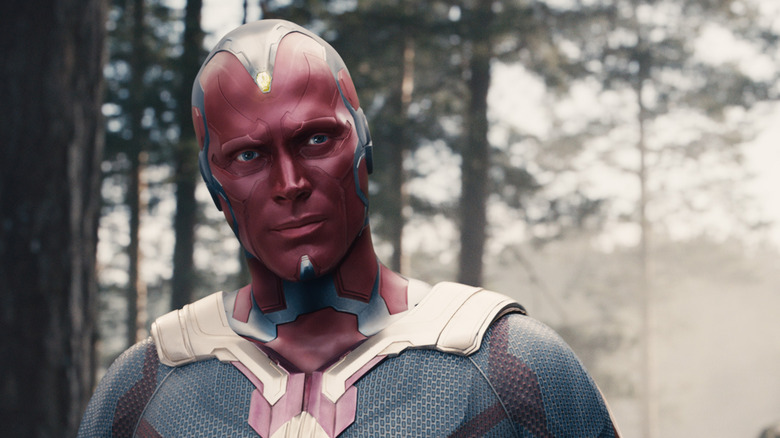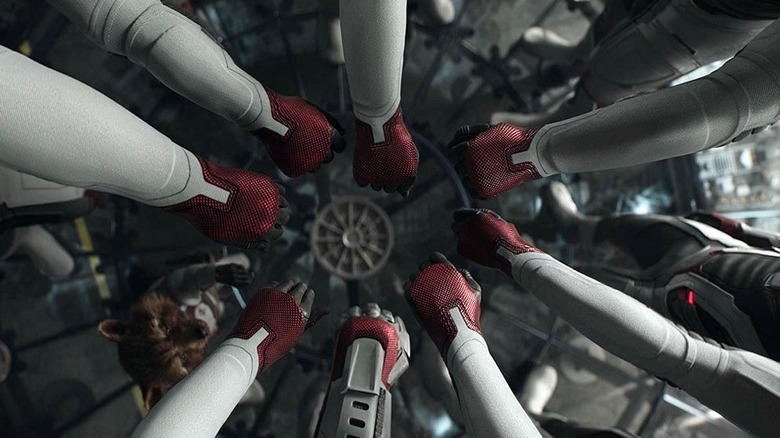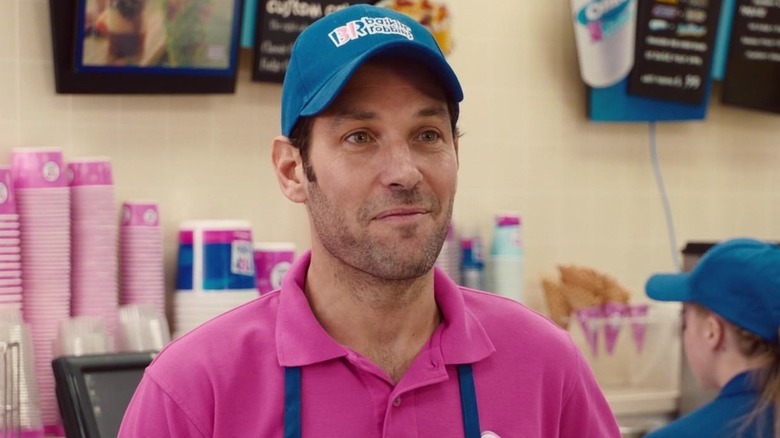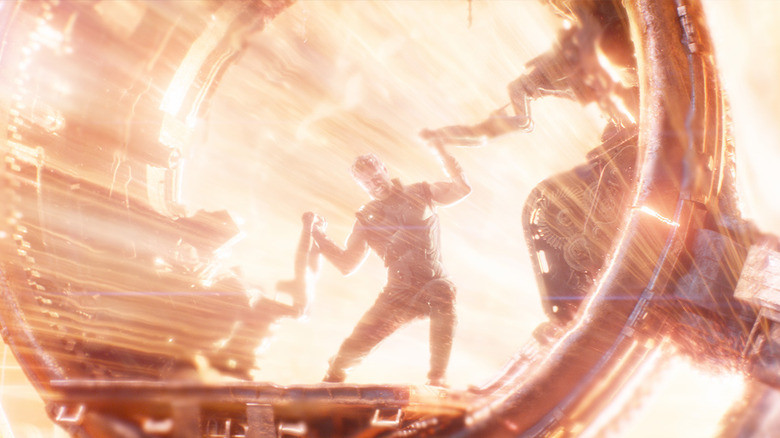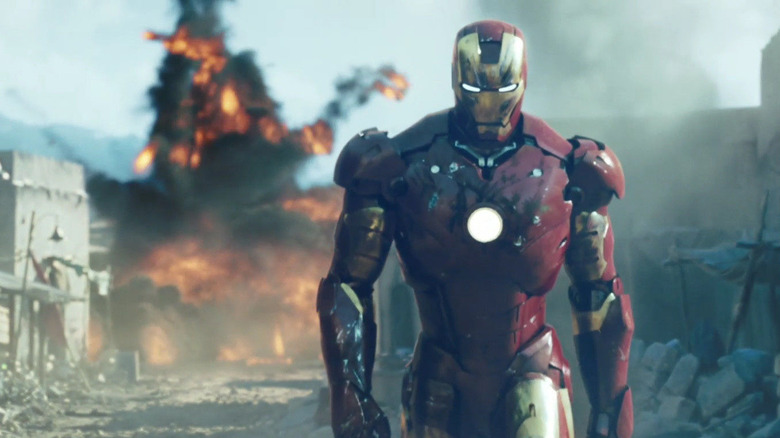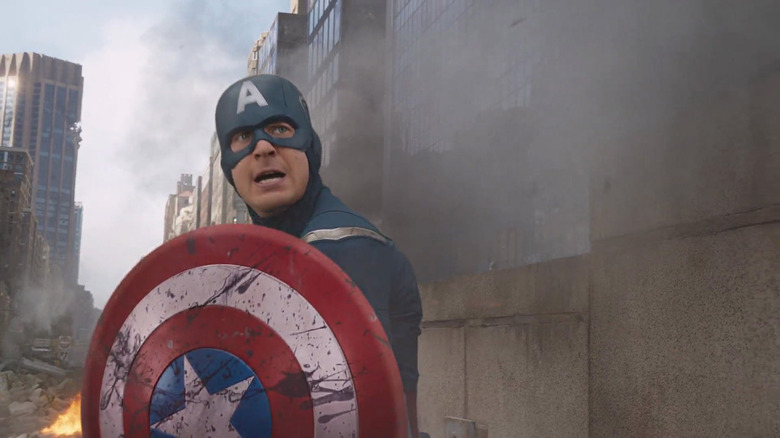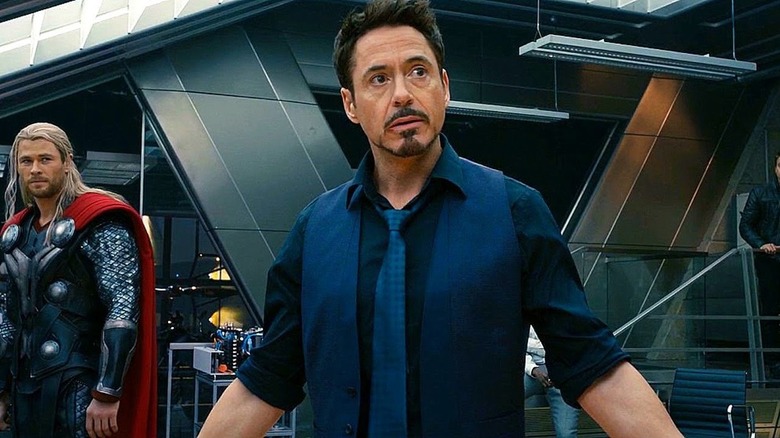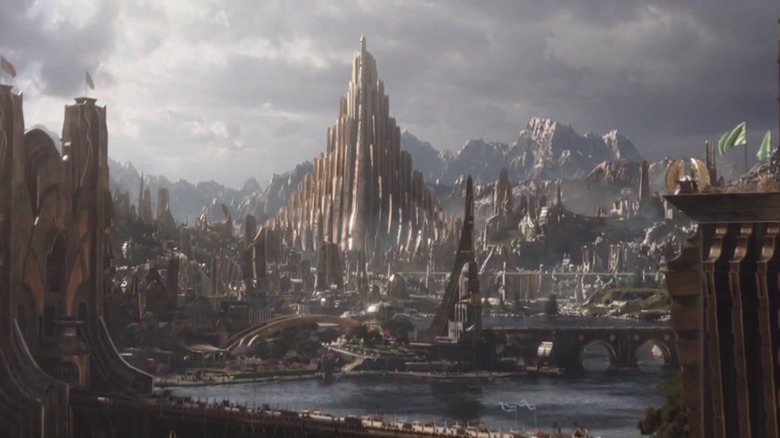Questionable Things We Ignore In The MCU
The MCU is a lot of things to a lot of people. Epic. Heroic. Overwhelming. The number-one stop in the galaxy for all things spandex. But for all of the guts and glory involved, there are also some less savory aspects of Marvel's beloved cinematic universe — weird, inconsistent things we're all too willing to ignore in the moment but which eventually turn up in conversation.
Sometimes they're minor things, little continuity errors that throw people off for a minute, like the fact that the Bifrost bridge is broken at the end of "Thor," is still broken in "Avengers," and is fixed without a second thought in "Thor: Dark World." At other times, a solution is retroactively woven into the story. For instance, after "Avengers," the studio made it painfully clear that the heroes were using in-ear comms to talk to one another so effortlessly. Wanda Maximoff's vacillating accent was also explained away as a varying attempt to avoid being identified by her Sokovian-sounding voice.
But there are many other instances during the MCU that have remained, well, questionable. There are countless moments that aren't just hard to wrap one's head around — they straight-up defy explanation or, at least, provide absolutely no information to help or hinder the endless string of fan theories that the Marvel fandom never fails to produce. We've gathered up some of the most obvious of these questionable candidates and listed them below. Enjoy!
Stark's easy-peasy Endgame science
Tony Stark is a genius. No one is arguing that fact. The man can builds smart homes, Iron Man suits, and superpowered sunglasses. But there are a couple of times that the Starkster's brilliance is pushed over the line, particularly in the penultimate film of the Infinity Saga, "Avengers: Endgame."
Let's start with time travel, shall we? When we first meet stark five years after the Snap, he's married, has a child, and is living in peaceful post-apocalyptic retirement. When Steve Rogers and company roll up to his door, he's naturally not pleased at their request to potentially upset things. Nevertheless, he ultimately puts his genius brain to work and, you know, figures out time travel. In, like, a few minutes. Sure, in reality, he was probably working on it offscreen, but still, for how long? A few days? A week or two? We're talking about time travel here.
And then there's the Stark Infinity Gauntlet. As if cracking the time travel code without breaking a sweat wasn't enough, the man goes and builds a gauntlet strong enough to channel the power of all six Infinity Stones — while no one else is even looking. We just see the stones popped into place, and, presto, the universe is fixed. Tony Stark is a lot of things. But a genius who can figure out time travel and build an Infinity Gauntlet back-to-back? It certainly stretches belief a bit.
Overpowered, underpowered Thanos
Thanos is a pretty tough dude. From the moment we meet him in the end credits of "Avengers," the villain's grizzled purple visage reveals a warrior who is as tough as he is fanatical. We see him taking out planets, taking on Avengers, and generally imposing his will on everyone around him — up to and not exceeding half of all life in the universe.
So, yeah, Thanos is a pretty tough guy. But the rugged ruffian isn't exactly what you'd call predictably tough. He's always hard to beat, but over the course of the Infinity Saga, the Mad Titan shows a fairly inconsistent amount of skills and power levels. Take, for instance, his "Infinity War" fight against the Guardians of the Galaxy and the Avengers on his MCU home planet of Titan.
In the conflict, Thanos wields a two-thirds complete Infinity Gauntlet that is powerful enough to bring a moon down on all and sundry. And yet, everyone — even Spider-Man and Drax — manages to get a hit in on the poor fellow. While he ends up winning, there are several points where victory seemed anything but a sure bet.
Contrast that with the end of "Avengers: Endgame," where the gauntlet-less scoundrel takes on Thor, Iron Man, and Captain America and manages to beat them all. The vacillating aspects of Thanos' strength, particularly with and without the Infinity Gauntlet, are a bit confusing. But who cares. It's freaking awesome to watch, right?
The Hulk/Banner personality shifts
The dual character of Hulk and Bruce Banner is a head-scratcher right from the get-go. And we get it: Two distinctly unique personalities sharing the same mind and body can get confusing. But that doesn't mean you can use it as an excuse to do whatever the heck you want to with the character.
The first time we meet Banner/Hulk in the MCU, the former is played by a somber Edward Norton, and the latter is a moody, sulky CGI-restricted manifestation of the Other Guy. The next time we meet the pair, the much lighter-hearted Banner is played by Mark Ruffalo, and the Jade Giant has taken on a laughable personality akin to a child with anger management issues.
Next thing you know, Hulk has been a gladiator on Sakaar for years. Eventually, Banner gets back on top in "Ragnarok," and then the two make amends between "Infinity War" and "Endgame," becoming Professor Hulk in the process. Even then, the newly spliced professor really feels like a version of Banner's mind in Hulk's body rather than a split personality of the two heroes.
The point is, as the Hulk/Banner story plays out, it doesn't feel very cohesive. Quite the opposite. The timeline feels stitched together with different creative minds giving input at different points. To be fair, Disney's lack of the Hulk rights was an issue hampering things. But still, when the dust settles, it's hard to make much sense of the character's story. So we just ignore it and move on.
Vision's lack of power is weird
Admittedly, a lot of the gripes on this list revolve around power levels in some form or another. It's hard to avoid the subject in a universe filled with superpowered beings with a smorgasbord of different origin stories. One of the biggest question marks on the list of power imbalances is Vision.
The android is a fascinating combination of artificial intelligence, vibranium ... and an Infinity Stone. Not surprisingly, it's that last part that doesn't really add up. How does Vision literally have an Infinity Stone buried in his forehead yet do so little in the Avengers' various conflicts? And you can't just say that the stone is meant to do other things. After all, Loki wields it to great effect in "Avengers," and it unleashes Wanda Maximoff's nearly limitless powers, too.
Having direct access to the Mind Stone should make Vision practically unstoppable. In comparison, Captain Marvel and the Scarlet Witch both come across as very capable, and they're just using powers that are tangentially related to Infinity Stones — they aren't wielding actual Stones. The main character you can compare Vision to is Doctor Strange, who happens to be about as overpowered as they come.
Now, just to clarify, Vision is really, really powerful. The question isn't if he's strong, though. It's why he isn't, like, way too over-the-top strong. How does Scarlet Witch put him in his place so easily? How does Hawkeye trap him in a force field? It just doesn't quite add up. Oh well.
Time travel: all of it
They had to go there, didn't they? "Endgame" was fun and exciting, but it also opened up a big old can of worms when it comes to time travel. Don't get us wrong. Marvel Studios cleverly buttoned up the issue as much as they could by clearly defining the MCU's version of time travel.
But the truth is, you can never really broach the subject of traveling through time without making everyone's heads hurt. Basic explanations like those given by the Ancient One don't really explain. More descriptive versions only become endless debates.
Up until the penultimate film of the Infinity Saga, there was one, easy-to-follow narrative for the MCU. Now, there's no end to the confusion. It took all of two seconds after "Endgame" came out for people to start questioning if Cap headed back to the main timeline or a deviant branch. Even the creators behind the film gave inconsistent answers.
Now, with the Time Variance Authority in the mix and the time-traveling villain Kang on the docket, the timeline-driven confusion only looks like it's going to get worse. On a certain level, who doesn't love the infinite possibilities of telling a story with time travel involved? That said, it's also really confusing and full of plot holes everywhere you turn. Please, Kevin Feige, just clearly tell us what to think, and we'll follow.
The cost of living in the MCU
When you have something as expansive as the MCU, you're going to overlook a lot of little things. Countless elements of daily life will go both unaddressed and usually unnoticed. But then, every once in a while, a little factoid will be brought into the limelight, only to leave everyone wondering, "Why would you do that to us?"
Case in point: How do heroes make their moolah in this world? It's a question that was largely left untouched for the first decade and change of the MCU. Everyone knew the easy outs, like Tony Stark's fortune or government payroll. But then the writers for "Falcon and the Winter Soldier" had to go and throw down the gauntlet by having Sam Wilson get turned down for a loan at the family bank.
After that, the question just hung there in the ether, unanswered and bothersomely relevant. With Tony Stark gone, how did the team pay for things like food and shelter and fancy superhero suits? It's easy to guess for some of them. Again, the concept of government pensions and paychecks quickly comes to mind.
But for others, the issue is perplexing. Does Sam Wilson at least have enough of an income to cover his own needs? Does he have time to deposit checks and go grocery shopping in between missions? What about others, like Professor Hulk or the orphaned and isolated Scarlet Witch? The issue didn't need to be addressed before. Now that it's been brought up, though, it's hard to ignore.
Thor's star power is out of this world
The next victim on our list of overpowered/underpowered grievances is Thor. The God of Thunder is an interesting conundrum. On the one hand, the dude can take on Hulk all day long — and laugh while being smashed and hurled about like nobody's business.
On the other hand, he can face down someone like his sister or Thanos and be beaten into a pulp. Sure, they're badass villains that actually can take Thor down in a fight, but seriously, Sparkles' pain tolerance seems really random. One minute, he's desperately fighting Malekith or tussling with a single Ultron Bot, and the next, he's taking on an entire world of Frost Giants or engaging in a knock-down, drag-out fight with Hulk.
If you really want to get picky, there's one truly awesome event that leaves MCU fans genuinely baffled: the star incident. In "Infinity War," Thor, Rocket, and Groot head to Nidavellir, the legendary dwarven world that circles a neutron star and harnesses its power. At the time, though, the star-powered forge has gone dark. Thor, desperate to create a newer, stronger weapon, decides to reignite the workshop ... by literally taking the full brunt of the star for upwards of a minute or more — depending on how you're counting. Considering the character's past displays of power, it doesn't take an astrophysicist to decipher that enduring a star's concentrated might for such a long time is literally unbelievable. And yet, we believe. Oh yes, we do. Hook. Line. And sinker.
Iron Man's endless ammunition
The Iron Man suits are pretty incredible. They're capable of flight, are AI-powered, and can head into space, put ships back together, and, by the end, even self-repair on the fly. The list of attributes associated with Stark's superhero finery is too big to count at this point. But that doesn't mean they all make sense — even for the MCU's aggrandized laws of science.
The main beef here is the quantity of stuff that the suits house at times, particularly when it comes to ammunition. Limitless repulsor blasts we can understand. After all, who are we to judge how much power an Iron Man suit can hold at one time? But the number of missiles, bullets, bombs, and other projectiles that come out of the suits at various moments tends to border on ridiculous.
The biggest issue usually revolves around full-scale battles. For instance, Iron Man's role in the Battle of New York in "Avengers" is basically the superhero equivalent of laying down suppressive fire. He returns to the firefight action in "Age of Ultron," as well, and is firing off at a rapacious rate in the last two "Avengers" films, too.
There are plenty of ways to explain this away, especially as the suits get more sophisticated. But the truth is, particularly earlier on, there's very little chance that a reasonable explanation can be cobbled together to satisfy the question of how Iron Man fits so much ammunition into such a small space.
The immortal Steve Rogers
We love the original Captain America as much as the next person, but that can't stop us from pointing out one of the character's biggest issues: He's darn near immortal. We're not talking about age: At the end of "Endgame," we see that a very long lifetime does slowly take its toll on that super soldier body of his.
We're talking about the good ol' risks of combat. Captain America is a war-prone fellow. He gets his start in World War II and is still punching his way through problems decades later. He fights regular soldiers, super soldiers, aliens, robots, and other heroes. And in all that time, all he has to protect his body is some skin-tight fabric and a shield about one third of his height.
Now, to be clear, this isn't a knock on Steve Rogers' battlefield prowess. On the contrary, Cap is an extraordinarily skilled fighter. The issue lies in the role of the dice. After his first film, we rarely see Rogers lift an offensive weapon. Instead, he uses his shield, regardless of whom he's fighting. And time and time again, he emerges from combat with nary a scratch. Occasionally he's dinged up a bit, and there's that time that he does get shot by the Winter Soldier. But honestly, that only drives the point home that much further. Is that really the only time in all of his long career that a bullet connects with Rogers? If so, that's pretty hard to believe, but we'll do so anyway.
Tony Stark's cash consumption
When the question of how the Avengers paid for everything comes up pre-"Endgame," it's easy to just say that Tony Stark footed the bill. And in many cases, that's doubtless what happened. Even if you remove the Avengers from the equation, the Man Who Has Everything clearly has no problem finding things to spend his money on.
Every one of Stark's houses is a splendiferous mansion replete with all of the latest Stark tech. His suits must cost a fortune to build. His car collection is robust. Heck, his dad literally had an entire shield made of vibranium just lying around before Steve Rogers got his hands on it.
The point is, the Starks, especially Tony, find ways to burn through cash. In fact, they rack up bills so well that, if you start to break things down, it can feel a bit over-the-top. For instance, a single Iron Man suit probably costs many millions of dollars ... and Stark builds dozens of them. He also funds projects like Veronica, builds the Avengers a home, buys countless gadgets for them to play with, and replaces anything that the team or their adversaries break. Add it all up, and it quickly starts to feel like even the richest man on Earth couldn't manage to pay for all of that tech. And yet, Stark never looks like he's hurting for cash. Not even a little bit. Go figure.
Asgard's population problems
Humanity is used to overpopulation concerns. However, there's one corner of the MCU that definitely doesn't have that problem: Asgard. In the second episode of "Loki," the God of Mischief stumbles upon a quick little infodump regarding the epic destruction of his homeland. The little reveal shows us that 9,719 individuals perished in the destruction. When the stat dropped, debate immediately flared up regarding whether this number applied to Hela's casualties, the Asgardians who were later killed by Thanos, or just those who died when Surtur's fiery judgment rained down on the planet.
Regardless of the specifics, though, it raised another question. Why are there so few people on Asgard in the first place? Are there really fewer than 10,000 people there when the kingdom is destroyed? After all, this is the top dog of the Nine Realms — a group of civilizations that also happens to include billions of humans. Did Odin really rule over so much with such a paltry number of individuals?
Of course, the average Asgardian is likely an extremely valuable member of their society compared to other populous people groups like the Outriders or Chitauri. But still, the numbers just don't add up when you're talking about the most powerful kingdom in all of the Nine Realms and even beyond. Now that there are apparently just hundreds or even dozens of Asgardians left, it will be interesting to see if the population issue is ever addressed or if the community is just left to dwindle away into obscurity.
